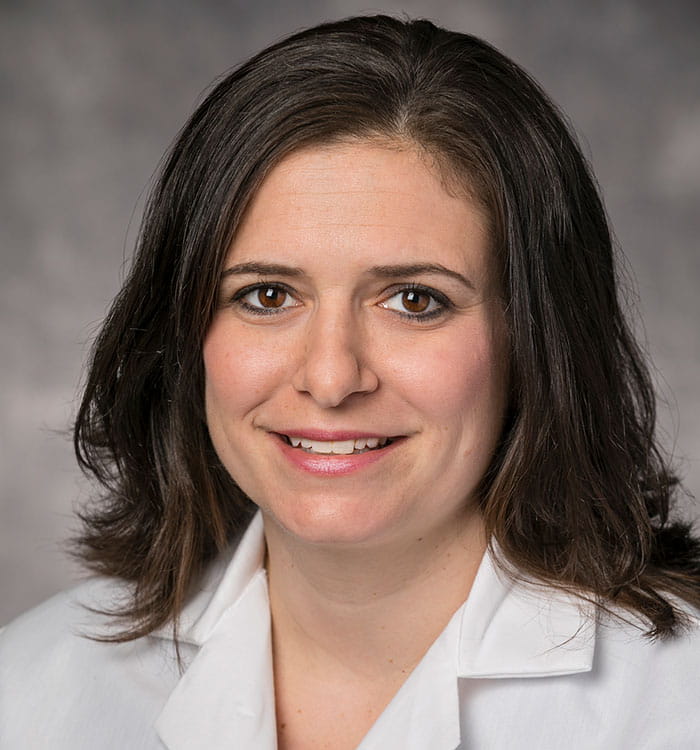University Hospitals Pushes for Improved Cervical Cancer Care Coordination
July 21, 2021
Dedicated nurse navigator among first steps taken to optimize communication
Innovations in Obstetrics & Gynecology | Summer 2021
The complexity of cervical cancer treatment requires gynecologic oncologists and radiation oncologists to work closely together. With different physician offices involved and multiple elements of treatment, getting patients through treatment in a timely manner is a challenge that requires precise case management.
 Amy Armstrong, MD
Amy Armstrong, MD Gordon Guo, MD
Gordon Guo, MDAt University Hospitals, the physicians treating this condition are working to improve their care coordination for this preventable cancer.
The HPV virus is responsible for the majority of cervical cancer cases, says Amy Armstrong, MD, gynecologic-oncologist at University Hospitals Cleveland Medical Center. But the HPV vaccine is widely available, and Pap smears are a regular screening test for cervical cancer.
Although the vaccine and screenings are available, there remains a disparity in screening, treatment and outcomes. “There is a disparity in cervical cancer in screening, prevention and treatment in African American women,” Dr. Armstrong says. “They at are higher risk of presenting at a later stage and receiving substandard care. It is an area with a lot of healthcare disparities and a lot of opportunities to improve care for these women.”
Coordinating care
Diagnosis is a crucial part of coordinating cervical cancer care. Women are likely to visit a primary care doctor or general gynecologist with their initial symptoms.
“Patients can experience bleeding or pain for a few months before they get to a cancer center,” says Gordon Guo, MD, radiation oncologist at UH Seidman Cancer Center.
Once a patient receives a diagnosis, the timeline for treatment becomes critical, Dr Guo says. “The literature suggests less than seven weeks of total treatment time for tumor control. That means chemo, radiation and brachytherapy.”
Ideally, there shouldn’t be any time gaps between the different elements of treatment, he says. “However, the coordination is very complex to minimize that gap.”
Without any help, patients have to navigate the health system, determining which offices to call for what and scheduling multiple appointments. Patients can easily become confused or discouraged.
“We know that missing treatments or appointments is associated with worse outcomes,” says Dr. Armstrong.
UH is looking for ways to optimize the care coordination process. Adding a dedicated nurse navigator is one of the first steps it has taken.
“I think care coordination and having someone that is a designated coordinator for the patient can really improve outcomes because it gives the patient one point person,” Dr. Armstrong says.
Instead of calling two different physician offices for appointments and questions, patients are able to connect with the nurse navigator. Instead of making 10 different phone calls to manage their treatment, patients have a single person responsible for guiding them through the entire process. That point person can answer questions about symptoms and medication and streamlines the entire scheduling process. The nurse navigator also serves as a critical communication point between the gynecological oncologists, radiation oncologists and chemotherapy nurses.
Continued improvement
Improving patient care and coordination is a continual process. Dr. Guo hopes to see more people join the team and support improved coordination. Dr. Armstrong is looking forward to continuing to develop a streamlined care path for all cervical patients, minimizing the amount of time it takes for insurance approvals and reducing the amount of time it takes to get from diagnosis to treatment.
“We are looking at our overall processes and trying to find small opportunities for improvements,” she says.
Communication remains a constant theme. Many cervical cancer patients come to UH with outside referrals. The team at UH needs to be able to communicate with these physicians, with internal team members and with patients. Transparent communication with patients can help to prepare them for treatment and set them up for success, Dr. Armstrong says.
As the team continues to find those opportunities to improve care coordination for cervical cancer patients, Dr. Armstrong is confident that UH stands behind their progress.
“We have support from the hospital and cancer center to try to improve care for these patients,” she says. “UH is really great at trying to support efforts to minimize disparities.”
Contact Dr. Armstrong at amy.armstrong@uhhospitals.org and Dr. Guo at Gordon.Guo@uhhospitals.org for more insight into UH’s approach to coordinated cervical cancer care.
Contributing Experts:
Amy Armstrong, MD
Division of Gynecologic Oncology
OB/GYN Residency Associate Program Director and Gynecologic Oncology Fellowship Associate Program Director
University Hospitals Cleveland Medical Center
Assistant Professor, Department of Reproductive Biology
Case Western Reserve University School of Medicine
Gordon Guo, MD
Radiation Oncology
University Hospitals Cleveland Medical Center
Associate Professor
Case Western Reserve University School of Medicine


